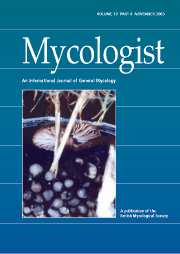Crossref Citations
This article has been cited by the following publications. This list is generated based on data provided by
Crossref.
2000.
21st Century Guidebook to Fungi.
p.
411.
2000.
21st Century Guidebook to Fungi.
p.
392.
Nordbring‐Hertz, Birgit
Jansson, Hans‐Börje
and
Tunlid, Anders
2006.
Encyclopedia of Life Sciences.
Liu, Xingzhong
Xiang, Meichun
and
Che, Yongsheng
2009.
The living strategy of nematophagous fungi.
Mycoscience,
Vol. 50,
Issue. 1,
p.
20.
Slepecky, Ralph A.
and
Starmer, William T.
2009.
Phenotypic plasticity in fungi: a review with observations onAureobasidium pullulans.
Mycologia,
Vol. 101,
Issue. 6,
p.
823.
McLoughlin, N.
Furnes, H.
Banerjee, N.R.
Muehlenbachs, K.
and
Staudigel, H.
2009.
Ichnotaxonomy of microbial trace fossils in volcanic glass.
Journal of the Geological Society,
Vol. 166,
Issue. 1,
p.
159.
Xie, Hongyan
Aminuzzaman, F. M.
Xu, Lingling
Lai, Yiling
Li, Feng
and
Liu, Xingzhong
2010.
Trap Induction and Trapping in Eight Nematode-trapping Fungi (Orbiliaceae) as Affected by Juvenile Stage of Caenorhabditis elegans.
Mycopathologia,
Vol. 169,
Issue. 6,
p.
467.
Niu, Xue-Mei
and
Zhang, Ke-Qin
2011.
Arthrobotrys oligospora: a model organism for understanding the interaction between fungi and nematodes.
Mycology,
Vol. 2,
Issue. 2,
p.
59.
Wei, Lu-Xia
Zhang, Hui-Xiang
Tan, Jian-Lin
Chu, Yan-Sheng
Li, Nan
Xue, Hua-Xi
Wang, Yan-Li
Niu, Xue-Mei
Zhang, Ying
and
Zhang, Ke-Qin
2011.
Arthrobotrisins A–C, Oligosporons from the Nematode-Trapping Fungus Arthrobotrys oligospora.
Journal of Natural Products,
Vol. 74,
Issue. 6,
p.
1526.
Nordbring‐Hertz, Birgit
Jansson, Hans‐Börje
and
Tunlid, Anders
2011.
Encyclopedia of Life Sciences.
Yang, Jinkui
Wang, Lei
Ji, Xinglai
Feng, Yun
Li, Xiaomin
Zou, Chenggang
Xu, Jianping
Ren, Yan
Mi, Qili
Wu, Junli
Liu, Shuqun
Liu, Yu
Huang, Xiaowei
Wang, Haiyan
Niu, Xuemei
Li, Juan
Liang, Lianming
Luo, Yanlu
Ji, Kaifang
Zhou, Wei
Yu, Zefen
Li, Guohong
Liu, Yajun
Li, Lei
Qiao, Min
Feng, Lu
Zhang, Ke-Qin
and
Andrianopoulos, Alex
2011.
Genomic and Proteomic Analyses of the Fungus Arthrobotrys oligospora Provide Insights into Nematode-Trap Formation.
PLoS Pathogens,
Vol. 7,
Issue. 9,
p.
e1002179.
Bíró-Stingli, Tímea
and
Tóth, Ferenc
2011.
The Effect of Trifender (Trichoderma Asperellum) and the Nematode-Trapping Fungus (Arthrobotrys Oligospora Fresenius) on the Number of the Northern Root-Knot Nematode (Meloidogyne Hapla Chitwood) in Green Pepper.
Journal of Plant Protection Research,
Vol. 51,
Issue. 4,
Ohashi, Takao
Fujiyama, Kazuhito
and
Takegawa, Kaoru
2012.
Identification of Novel α1,3-Galactosyltransferase and Elimination of α-Galactose-containing Glycans by Disruption of Multiple α-Galactosyltransferase Genes in Schizosaccharomyces pombe.
Journal of Biological Chemistry,
Vol. 287,
Issue. 46,
p.
38866.
Zhang, Hui-Xiang
Tan, Jian-Lin
Wei, Lu-Xia
Wang, Yan-Li
Zhang, Chuan-Ping
Wu, De-Kai
Zhu, Chun-Yan
Zhang, Ying
Zhang, Ke-Qin
and
Niu, Xue-Mei
2012.
Morphology Regulatory Metabolites from Arthrobotrys oligospora.
Journal of Natural Products,
Vol. 75,
Issue. 7,
p.
1419.
Andersson, Karl-Magnus
Meerupati, Tejashwari
Levander, Fredrik
Friman, Eva
Ahrén, Dag
and
Tunlid, Anders
2013.
Proteome of the Nematode-Trapping Cells of the Fungus Monacrosporium haptotylum.
Applied and Environmental Microbiology,
Vol. 79,
Issue. 16,
p.
4993.
Hsueh, Yen-Ping
Mahanti, Parag
Schroeder, Frank C.
and
Sternberg, Paul W.
2013.
Nematode-Trapping Fungi Eavesdrop on Nematode Pheromones.
Current Biology,
Vol. 23,
Issue. 1,
p.
83.
Singh, Udai B.
Sahu, Asha
Sahu, Nisha
Singh, Bhanu P.
Singh, R.K.
Renu
Singh, Dhananjaya P.
Jaiswal, R.K.
Sarma, B.K.
Singh, H.B.
Manna, M.C.
Rao, A. Subba
and
Prasad, S. Rajendra
2013.
Can endophytic Arthrobotrys oligospora modulate accumulation of defence related biomolecules and induced systemic resistance in tomato (Lycopersicon esculentum Mill.) against root knot disease caused by Meloidogyne incognita.
Applied Soil Ecology,
Vol. 63,
Issue. ,
p.
45.
Yang, Jinkui
Yu, Yan
Li, Juan
Zhu, Wei
Geng, Zongyi
Jiang, Dewei
Wang, Yunchuan
and
Zhang, Ke-Qin
2013.
Characterization and functional analyses of the chitinase-encoding genes in the nematode-trapping fungus Arthrobotrys oligospora.
Archives of Microbiology,
Vol. 195,
Issue. 7,
p.
453.
Chen, Yuan‐Li
Gao, Ying
Zhang, Ke‐Qin
and
Zou, Cheng‐Gang
2013.
Autophagy is required for trap formation in the nematode‐trapping fungus Arthrobotrys oligospora.
Environmental Microbiology Reports,
Vol. 5,
Issue. 4,
p.
511.
Liang, Lianming
Wu, Heng
Liu, Zhiheng
Shen, Renfei
Gao, Hong
Yang, Jinkui
and
Zhang, Keqin
2013.
Proteomic and transcriptional analyses of Arthrobotrys oligospora cell wall related proteins reveal complexity of fungal virulence against nematodes.
Applied Microbiology and Biotechnology,
Vol. 97,
Issue. 19,
p.
8683.

